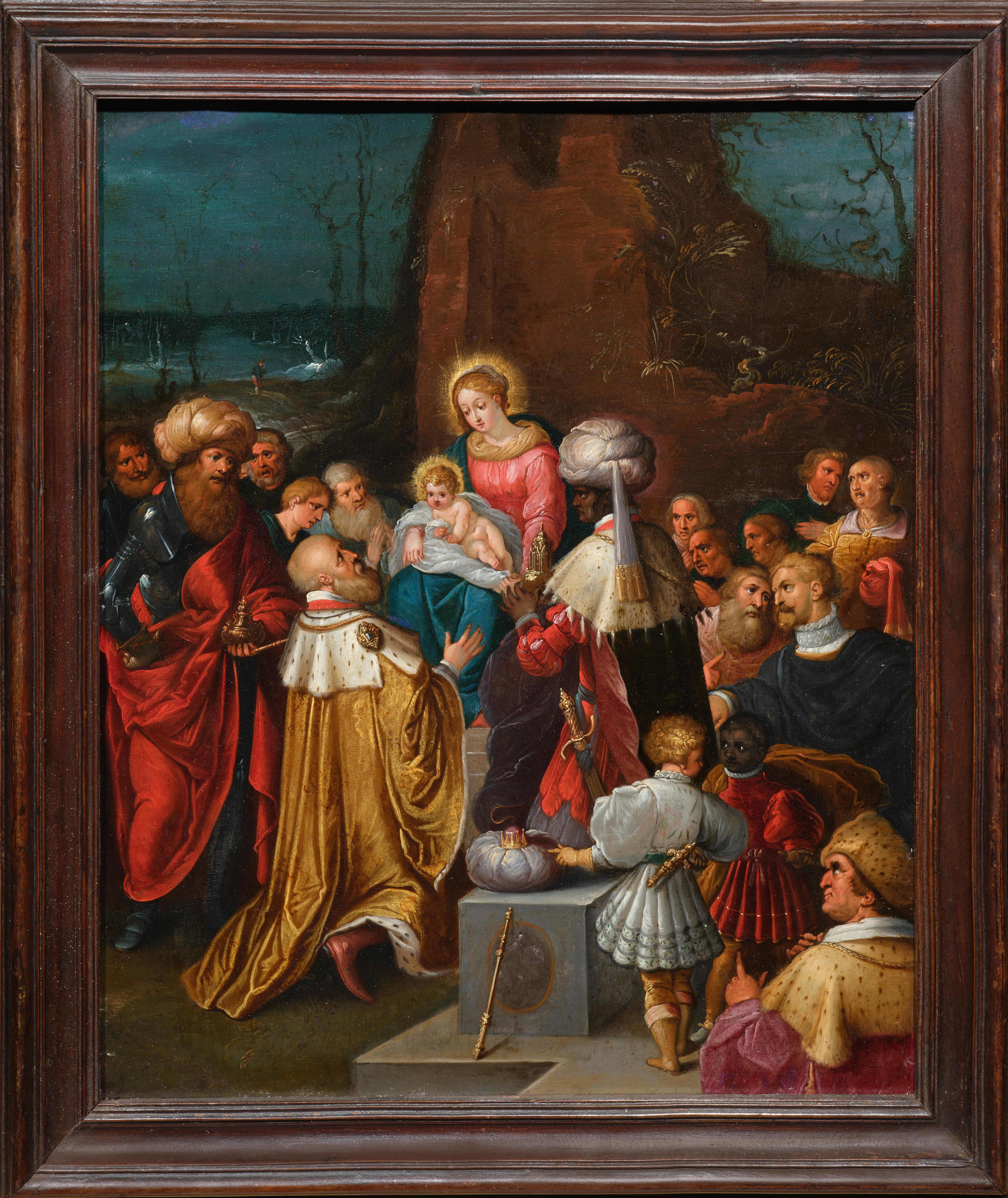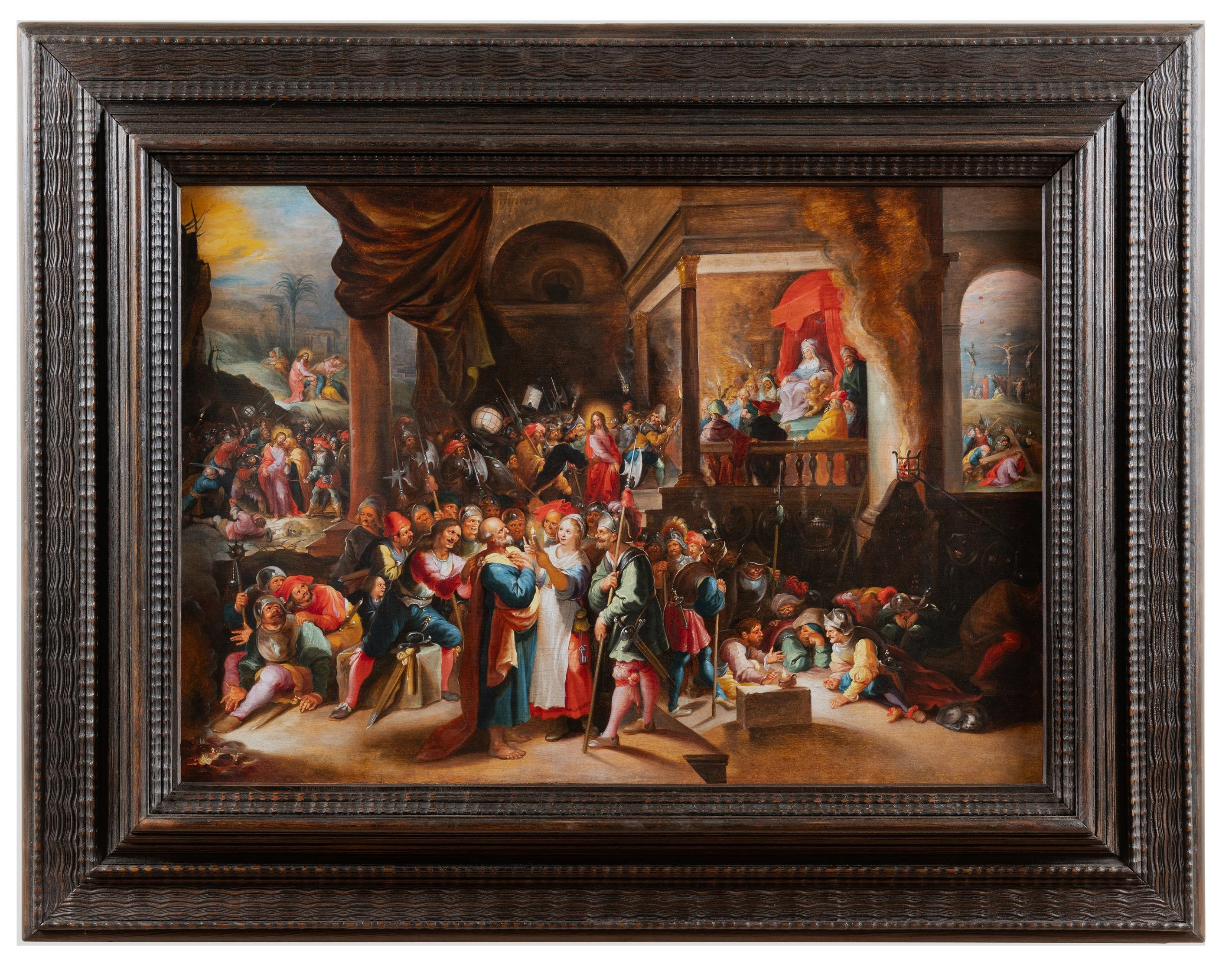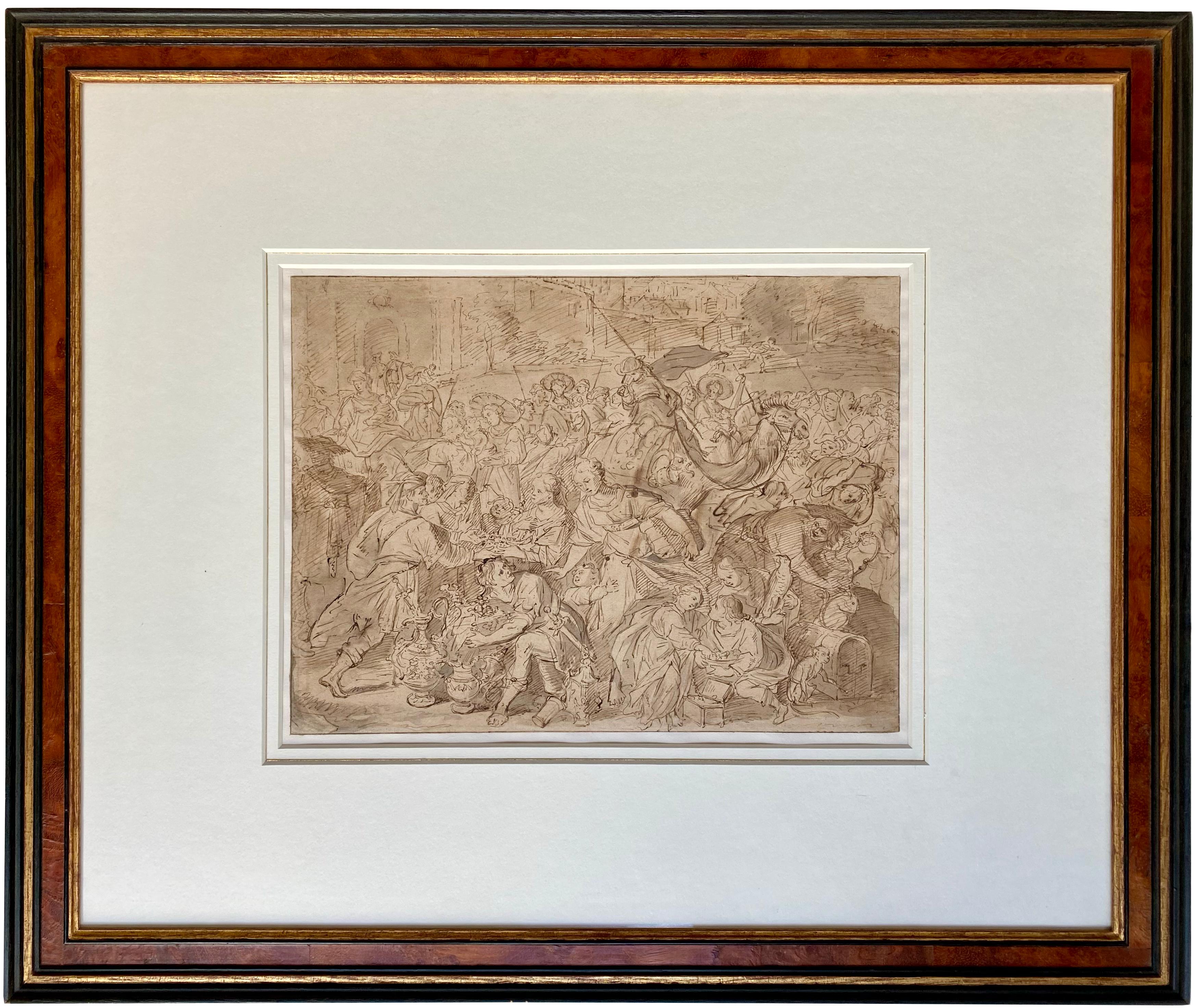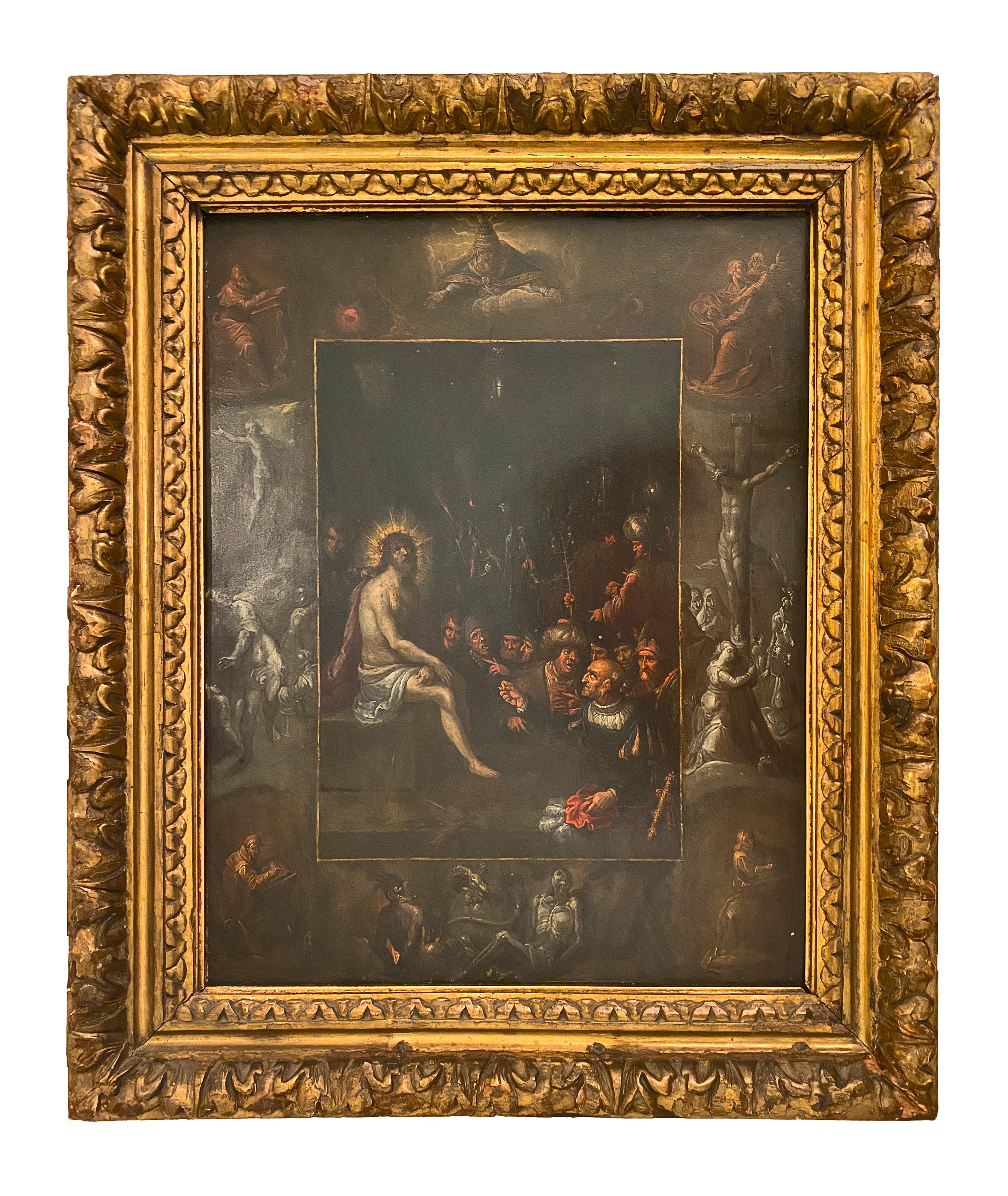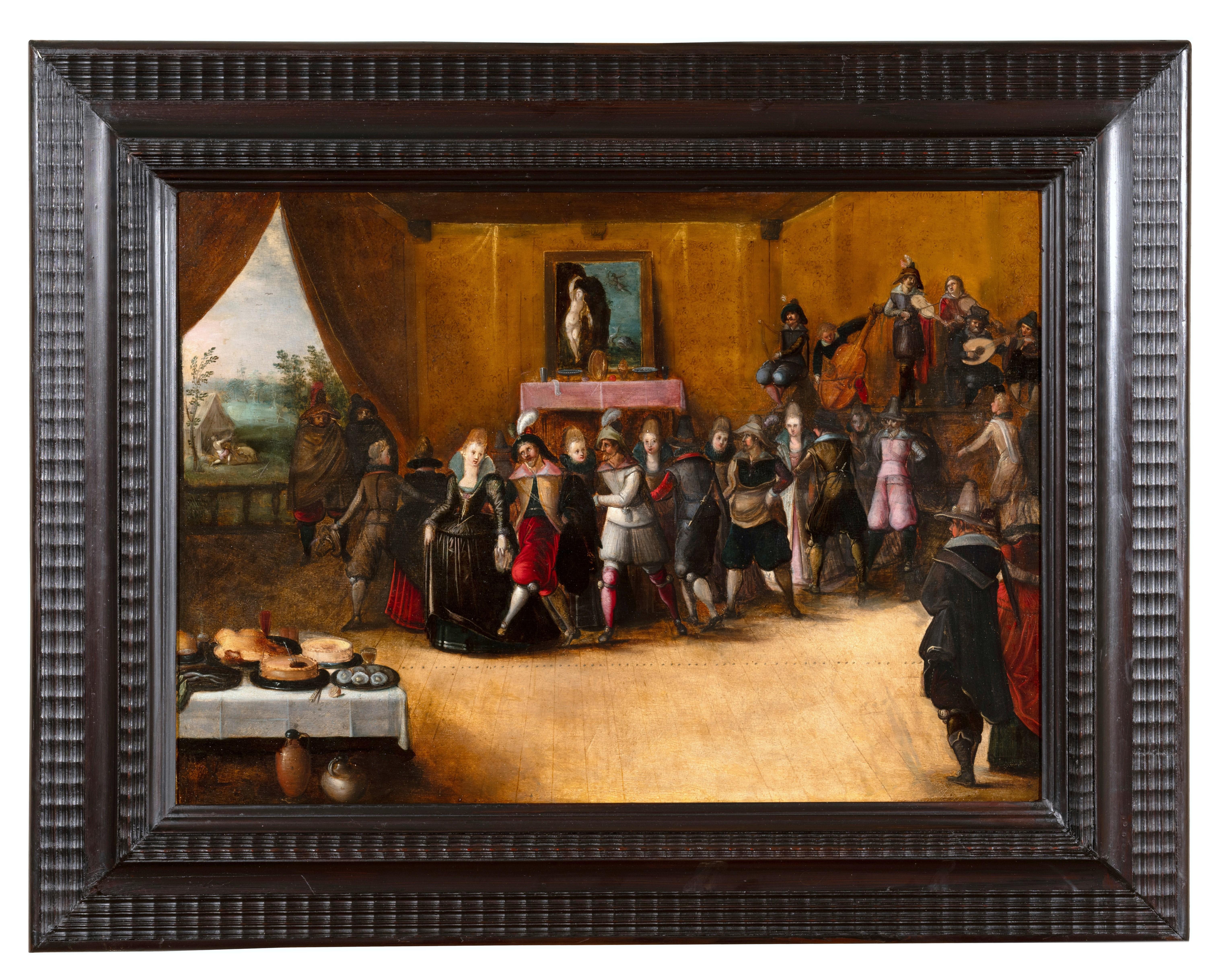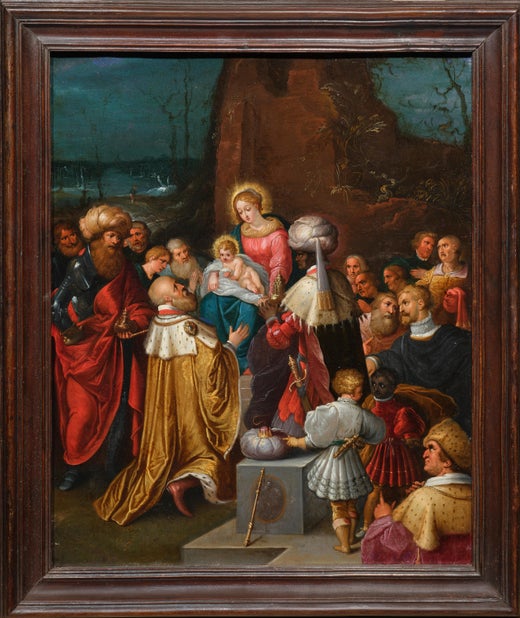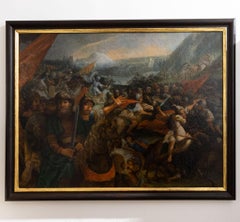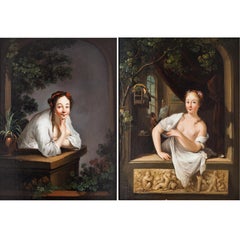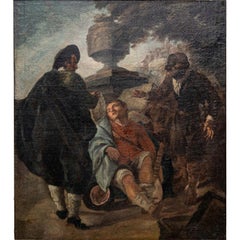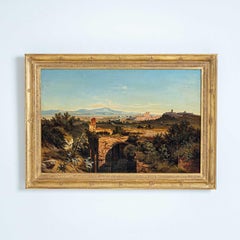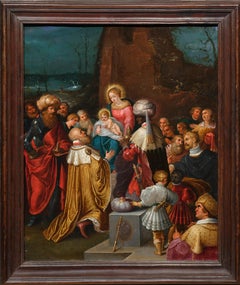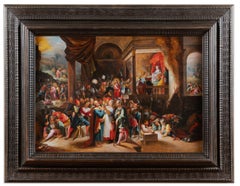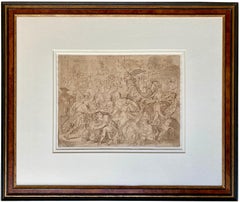Items Similar to The Idolatry of Solomon after Frans Francken the Younger (Flemish, 1581–1642)
Want more images or videos?
Request additional images or videos from the seller
1 of 13
Frans Francken IIThe Idolatry of Solomon after Frans Francken the Younger (Flemish, 1581–1642)
$8,387.01
£6,242.42
€7,000
CA$11,488.10
A$12,777.28
CHF 6,671.90
MX$155,485.85
NOK 85,210.29
SEK 79,912.22
DKK 53,288.56
Shipping
Retrieving quote...The 1stDibs Promise:
Authenticity Guarantee,
Money-Back Guarantee,
24-Hour Cancellation
About the Item
This painting depicts "The Idolatry of Solomon," inspired by Frans Francken the Younger, a Flemish Baroque painter. The subject was particularly popular in Protestant countries as it addresses the issue of idolatry. The scene portrays King Solomon, who, in his old age, turns to the pagan religions of his many wives. He is shown worshipping an idol reminiscent of Triton, while one of his wives instructs him in the act. On the right side of the painting, men observe the proceedings with skepticism. The original work by Frans Francken is presented in landscape format and mirrored. Frans Francken the Younger was renowned for his detailed and narrative depictions of biblical themes.
Medium: Oil on wood
Image Dimensions: 65 x 49.5 cm
Frame: Gold-patinated, profiled frame
- Creator:Frans Francken II (1581 - 1642, Flemish)
- Dimensions:Height: 32.68 in (83 cm)Width: 26.78 in (68 cm)Depth: 1.58 in (4 cm)
- Medium:
- Movement & Style:
- Period:Early 17th Century
- Condition:
- Gallery Location:Greding, DE
- Reference Number:Seller: 084-16941stDibs: LU1304215888342
Frans Francken II
Frans Francken the Younger is the best-known member of an extended artistic family that worked in Antwerp from the late sixteenth to the late seventeenth century. Born in 1581, he almost certainly studied with his father, Frans Francken the Elder (c. 1542-1616), before becoming a master in the Antwerp Saint Luke's Guild in 1605. In 1627 he became a member of the Antwerp archers' guild De Oude Handboog. Francken was an extremely productive and imaginative artist who specialized in expressively rendered small-scale religious and mythological scenes. He also painted larger altarpieces for Catholic churches. His depictions of collectors' cabinets introduced a genre of painting that influenced several artists, including Jan Brueghel the Elder and David Teniers the Younger. Francken ran a large and productive workshop, where he was assisted by a number of pupils, including his sons Frans III (1607-1667), Hieronymus III (1611-after 1661), and Ambrosius III (c. 1614-1662). Also active in his studio were his brothers Thomas (1574-c. 1626), Hieronymus the Younger (1578-1623), and Ambrosius the Younger (c. 1590-1632). Francken painted many works for the art dealer Christian van Immerzeel, who sold them to Spanish collectors. Francken frequently collaborated with other artists. For example, he painted figures in landscapes by Abraham Govaerts (1589-1626) and Joos de Momper II (1564-1635) and in architectural scenes by Bartholomeus van Bassen (c. 1560-1652) and Peeter Neeffs the Elder. He also collaborated with flower painters, among them Jan Brueghel the Elder, Jan Brueghel the Younger (1601-1678), and Andries Danielsz (active c. 1600-1625).
About the Seller
5.0
Vetted Professional Seller
Every seller passes strict standards for authenticity and reliability
1stDibs seller since 2019
- ShippingRetrieving quote...Shipping from: Greding, Germany
- Return Policy
Authenticity Guarantee
In the unlikely event there’s an issue with an item’s authenticity, contact us within 1 year for a full refund. DetailsMoney-Back Guarantee
If your item is not as described, is damaged in transit, or does not arrive, contact us within 7 days for a full refund. Details24-Hour Cancellation
You have a 24-hour grace period in which to reconsider your purchase, with no questions asked.Vetted Professional Sellers
Our world-class sellers must adhere to strict standards for service and quality, maintaining the integrity of our listings.Price-Match Guarantee
If you find that a seller listed the same item for a lower price elsewhere, we’ll match it.Trusted Global Delivery
Our best-in-class carrier network provides specialized shipping options worldwide, including custom delivery.More From This Seller
View AllLarge Painting of a Battle, Figurative Painting, 18th Century
Located in Greding, DE
Antique battle scene with horsemen in front of landscape scenery. Oil on canvas. Framed in a black wooden frame with a gold patinated moulding. The canvas with strong craquelure. Siz...
Category
18th Century Figurative Paintings
Materials
Oil
Attributed to C. W. E. Dietrich, Pendant Window Paintings, Oil on Wood
Located in Greding, DE
Pendant window pictures attributed to Christian Wilhelm Ernst Dietrich, called Dietricy (1712 Weimer - 1774 Dresden).
Typical genre depiction of two pretty young ladies leaning out of arched windows. Both ladies are shown open-hearted with white blouses. One painting shows a lady with a red hair band and red cheeks leaning on a low railing and looking at the observer with a slightly glassy gaze. The window opening is framed with vine tendrils and a Mediterranean potted plant on the left edge of the painting.
The other painting shows a young beauty with flowers in her hair, leaning loosely out of a window opening with a relief depiction of putti and the same green vine leaves. A red velvet...
Category
18th Century Baroque Figurative Paintings
Materials
Wood, Oil
Egidio dall'Oglio (1705-1784), Boy with Lute and Two Fighting Men, Italy 18th C
Located in Greding, DE
Depiction of a young man with a lute sitting between two quarrelling men.
Painting in oil on canvas
Image size: 58 x 50 cm.
In a baroque gold stucco frame.
The reverse with old galle...
Category
18th Century Figurative Paintings
Materials
Canvas, Oil
Johann Anton Castell (1810 Dresden - 1867 ibid.), Mediterranean Landscape
Located in Greding, DE
A Mediterranean landscape with ruins, agaves and a sweeping view of a mountain range. The landscape could be in Sicily, possibly near Taormina, an area that Castell has already depic...
Category
1840s Landscape Paintings
Materials
Oil
August Querfurt (attributed, 1696–1761), Hunting Party, First Half of the 18th C
By August Querfurt
Located in Greding, DE
Oil painting depicting a vivid hunting scene with a mounted party, accompanied by hunting dogs and a slain doe in the foreground. Set against a sweeping landscape with a farmhouse, t...
Category
Early 18th Century Landscape Paintings
Materials
Oil
Bronze Relief by Max Wach-Wacheneck (*1871 Berlin), cast by Noack Berlin, 1909
Located in Greding, DE
A large-scale bronze high relief with a depiction of a young undressed woman and two old men. The scene takes place in an architectural setting inspired by antiquity, with a suggeste...
Category
Early 1900s Figurative Sculptures
Materials
Bronze
You May Also Like
The Adoration of the Magi, an early painting by Frans Francken II (1581 - 1682)
By Frans Francken II
Located in PARIS, FR
We would like to thank Dr. Ursula Härting who, after examining the work, confirmed the autograph nature of this painting by Frans Francken the Younger in a certificate issued on Dece...
Category
1610s Old Masters Figurative Paintings
Materials
Copper
Hieronymus FRANCKEN III - The Denial of Saint Peter, 17th c. Antwerp school
Located in PARIS, FR
Hieronymus FRANCKEN III (Antwerp 1611 - 1671)
17th century Antwerp School
The Denial of Saint Peter
Oil on panel, dim. h. 53 cm, l. 76 cm
Framed, h. 82 cm, l. 106 cm
Sold with the ...
Category
Mid-17th Century Old Masters Figurative Paintings
Materials
Oil, Wood Panel
'The Departure of the Israelites from Egypt' by Frans Francken the Younger
Located in Knokke, BE
Frans Francken the Younger
1581 - Antwerp - 1642
Flemish Painter
'The Departure of the Israelites from Egypt – The Exodus', c. 1610 - 1620
Medium: pen in sepia on paper
Dimensions: mage size 26 x 34,5 cm, frame size 55 x 65,5 cm
Biography: Frans Francken the Younger, born in Antwerp in 1581 and passing away on May 6, 1642, also in Antwerp, was a distinguished Flemish painter. He is recognized as the most prominent and productive member of the renowned Francken family of artists. Francken explored a wide range of subjects, creating large altarpieces for churches and producing smaller works depicting historical, mythological, and allegorical scenes. Notably, his depictions of collectors’ cabinets established a popular new genre of art during his era. He was known for collaborating with other artists, enriching their works with his skilled renderings of figures and narrative elements, complementing specialists in landscape, architectural scenes, and floral still-life painting.
Francken was born to Frans Francken the Elder and Elisabeth Mertens. His father was a pupil of Antwerp’s leading history painter, Frans Floris, and a significant creator of altarpieces in Flanders during his time. Francken received his artistic training under the guidance of his father. Additionally, it is possible that Frans and his brother, Hieronymus Francken II, received further instruction in the workshop of their uncle, Hieronymus Francken I, in Paris.
A versatile artist, Francken made significant contributions to various genres within Flemish art, introducing new themes and subjects. Many of his works comprised small-scale historical, allegorical, and biblical cabinet paintings, often emphasizing figures. He is credited with either inventing or popularizing several novel themes that gained popularity in Flemish painting, including genre scenes featuring monkeys (also known as singeries) and Kunstkammer or gallery paintings, presenting a plethora of natural and artistic treasures against a neutral wall. Francken introduced various other unconventional themes that later gained traction, such as the ‘Triumphal Procession of Amphitrite’ and ‘Croesus and Solon.’ He also produced a series of paintings depicting witches and witchcraft, including portrayals of witches’ sabbats.
His remarkable paintings are held in the collections of numerous major museums throughout Europe. Francken specialized in rendering the human figure, as evidenced by etched and engraved portraits of the artist by Anthony van Dyck (after Peter Paul Rubens), identifying him with the Latin inscription: ‘ANTVERIÆ PICTOR HVMANARVM FIGVRARVM’ (Figure painter of Antwerp). He was frequently invited to contribute figures to compositions by other esteemed artists, including landscape artists such as Tobias Verhaecht, Abraham Govaerts, and Joos de Momper...
Category
Early 17th Century Baroque Interior Paintings
Materials
Paper, Pen
The Preaching of St. John the Baptist, Workshop of Fans Francken II, 1600s
Located in Milan, IT
The sermon of the Baptist is set in a large open space, with rich vegetation and wooded glimpses, and on the back, in the distance, you can see the buildings of a city.
The scene see...
Category
17th Century Other Art Style Figurative Paintings
Materials
Oil
Mocking of Christ, by Frans Francken (II) and possibly Ambrosius Francken (II)
By Frans Francken II
Located in New York, NY
Mocking of Christ, with all around in grisaille: the Crucifixion, the Resurrection, God the Father, Mankind after the Fall,; in the corners the four evangelists.
J. Dijkstra ao, cat. The paintings of Museum Catharijneconvent, Utrecht (Museum Catharijneconvent) 2002, p. 196, pict., as Frans Francken...
Category
17th Century Mannerist Figurative Paintings
Materials
Copper
$5,200 Sale Price
56% Off
Free Shipping
Attributed à H. Francken II, 17th c. Anwerp - The prodigal son among courtesans
Located in PARIS, FR
The Prodigal Son Among Courtesans
Attributed to Hieronymus Francken II (Antwerp 1578-1623)
Early 17th century Antwerp school
Oil on oak panel,
Dimensions: H. 52.5 cm (20.67 in), W. 74 cm (29.14 in)
Flemish-style moulded wood frame
Frame: h. 78 cm (h. 30.70 in.), w. 100 cm (39.37 in.)
At first glance, this festive and joyful painting depicts a group of elegantly dressed people dancing to the sound of an orchestra in a richly decorated interior with a wide opening onto a rural exterior. However, the real theme is cleverly concealed by the painter and is only discernible through the artifice of a small scene in the background where we see a half-naked man, in the company of the pigs next to a makeshift shelter.
In fact, beyond the pleasant and apparently superficial character of the painting, it is a subject taken from the parable of the prodigal son in the Gospel. The illustrated episode is the prodigal son among courtesans.
Even if the viewer's attention is drawn to the central couple (prodigal son embracing a pretty courtesan) doing the dance steps, the artist takes care in a narrative approach of all the groups and ancillary scenes in order to create a rich and varied composition. Thus the musicians seated on a raised platform are depicted with great skill, their faces animated, their clothes abundantly varied.
The theme of music, which has always been associated with that of sensuality and physical love, helps to exacerbate licentious pleasures.
The merry company dances "Spanish pavane", a slow court dance from the sixteenth century, danced close to the ground by couples arranged in a procession, which was probably introduced to the south of the Netherlands around 1600 during the governance of Albrecht VII and the daughter of the King of Spain Isabella Clara Eugenia in Brussels.
The interior of the house is also carefully elaborated, the embossed leather dyes on the walls, the middle sideboard (typical in Francken interiors), where the rich gold and silver crockery is placed in front of the painting "Andromeda chained to the rock and Perseus arriving to rescue her". The inclusion of a contemporary and probably extant pictorial work is also one of the characteristics of the Francken family, among them Frans Francken the Younger...
Category
Early 17th Century Old Masters Interior Paintings
Materials
Oak, Oil
